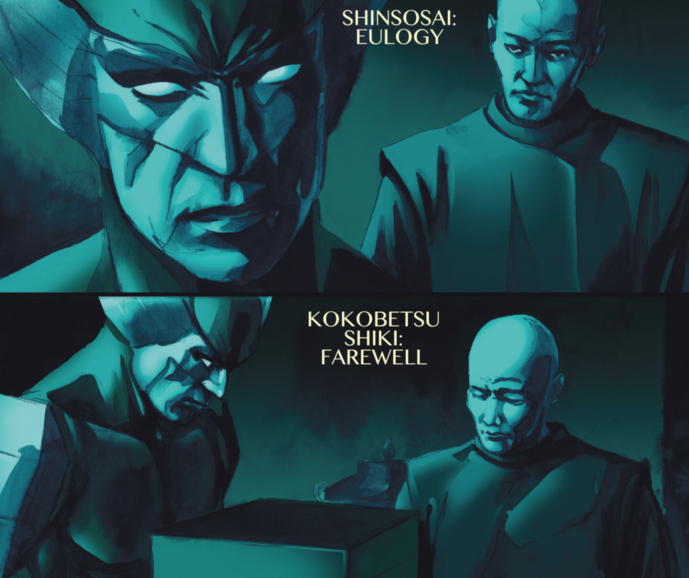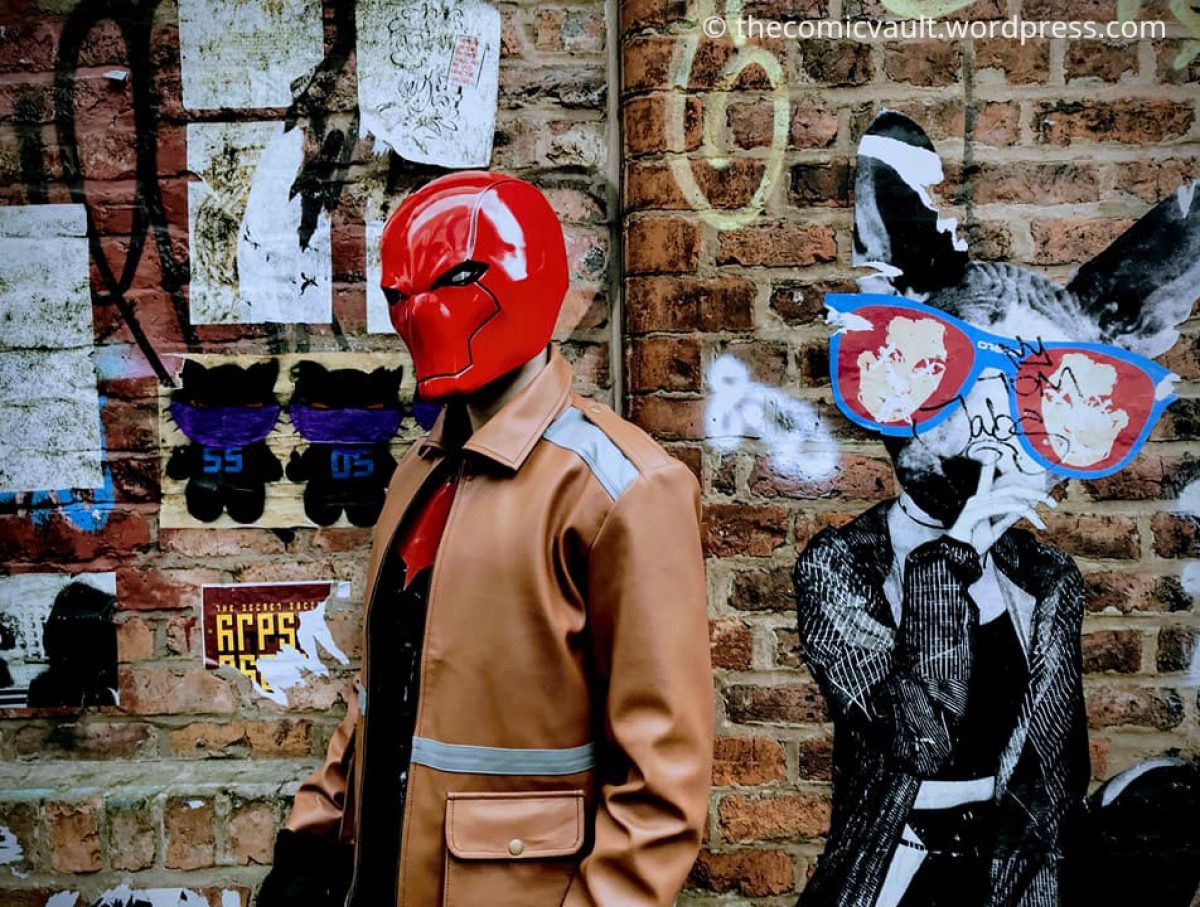Everyone has their own way of coping with death, whether through carrying out their own personal rituals or spending time with loved ones. The passing of my grandad has made me think about the burial ceremonies from different cultures, with comics offering an insight into the various practices. After all, death is never constant in comics. But we still mourn characters if we’ve read about them for years. Japanese funerals are some of the most elaborate, so it seemed appropriate that Wolverine’s death would be honoured through a culture that shaped his life.
During the Death of Wolverine arc, Logan’s son, Daken, carried out a traditional Shinto funeral for his father. Shinto funerals have twenty steps and I’m looking into each one as a way of seeing how grief is processed.
Step 1 – Matsugo No Mizu (Washing The Lips)
The first step in a Shinto funeral is known as the ‘washing the lips.’ This involves a relative wetting the lips of the dead, which acts as a symbolic gesture for the body having its last taste of water. The first step is performed as close to the time of death as possible. To start the funeral, Daken took Wolverine’s remains to a Shinto priest in Okinawa.

Step 2 – Yukan (Washing The Body)
The second step, called yukan, involves the body being washed. Yukan is done for practical and ceremonial reasons. Several family members can take part in washing the body.
Step 3 – Kiyu Hokoku (Announcement Of Death)
The third step is based around the family announcing to the spirit world that a person is dead. This is done through prayer and usually carried out at a family shrine.
 Step 4 – Makura Naoshi No Gi (Laying The Body Down)
Step 4 – Makura Naoshi No Gi (Laying The Body Down)
The fourth step of the ritual involves the body being set down with the head propped up on a pillow. Makura Noashi No Gi can be translated as ‘pillow decorations,’ with the body always facing north. Food offerings are given to the gods, while a sword or knife is placed beside the dead.
Step 5 – Nokan No Gi (Placing In The Coffin)
Step five is straightforward because the body is placed within a coffin. In Wolverine’s case, Daken chose to let the priest carry out his work alone.
Step 6 – Kyuzen Nikku (Offerings For The Deceased)
Kyuzen Nikku involves more food, though it’s different from step four because meals are offered to the dead. Traditionally, the offerings are the favourite meals of the deceased, made twice a day until the final resting place is given.
Step 7 – Ubusuna Jinja Ni Kiyu Hokoku (Announcement Of The Return Of The Spirit)
The seventh step focuses on the spirit returning to the local shrine. From Daken’s perspective, I imagine him believing his father’s spirit to be one of the most powerful forces in the world.
Step 8 – Bosho Batsujo No Gi (Purifying The Ground)
This step is meant to act as a purification ritual. A priest concentrates on purifying the earth that will be used as the grave site. The process is done through a combination of water and prayer.
Step 9 – Kessai (Purifying The Self)
Kessai involves the priest purifying himself in preparation for the funeral. This may be done by a priest pouring water over himself.
Step 10 – Tsuya Sai (The Wake)
The wake occurs at the half way point, with the family gathering together to remember the dead. Priests offer prayers and thank mourners for attending the funeral. Daken was the only one present at Wolverine’s wake and shared a drink with the priest.
Step 11 – Senrei Sai (Transferring The Spirit)
Senrei sai is about transferring the deceased’s spirit from the body into a wooden box. The box is held over the body, representing the separation.
Step 12 – Settai (Refreshments)
Settai involves mourners eating food that’s been prepared in a different location. This is done to avoid the contamination of death and the food could range from a small snack to a large meal.
Step 13 – Shinsosai (Eulogy)
The formal funeral service happens with shinsosai. The funeral room is purified, offerings are made to the gods and eulogies are carried out to honour the dead.
Step 14 – Kokobetsu Shiki (Farewell)
This step is focused on mourners saying goodbye to the deceased. A single file line is formed, with each mourner walking past the body to give a final farewell.
Step 15 – Hakkyu Sai No Gi (Departure Of The Coffin)
The coffin is prepared to travel to the grave site during the fifteenth step. A banner-decorated sword may be placed on the coffin as a way of letting the dead know that it’s time to move on. Daken chose to transfer his father’s remains in a small box, demonstrating a less elaborate approach.
Step 16 – Soretsu (Funeral Procession)
The funeral procession happens with the sixteenth step and the coffin is taken to a cemetery or crematorium.
 Step 17 – Hakkyu-Go Batsujo No Gi (Purification Of The House)
Step 17 – Hakkyu-Go Batsujo No Gi (Purification Of The House)
This step is one of the most intimate parts of the entire ceremony. The home where the funeral has taken place is purified after the body has been removed. A new altar is set up inside the house. Daken’s family altar was made up of pictures of his mother and father side by side.
Step 18 – Maisosai (Burial Rites)
Burial rites are performed during the eighteenth step. The priest will pray and offerings are made on behalf of the deceased.
Step 19 – Kotsusage (Removal Of The Bones)
Perhaps the most intimate step, kotsusage involves the literal picking up of bones. A family member plucks the bones of a loved one with chopsticks and places them inside a vase. The bones come out of the crematorium ash. In a symbolic gesture, Daken picked up a claw fragment from his father and placed it inside a vase.
Step 20 – Kika Sai (Coming Home)
For the final step, ashes that haven’t been buried are brought home and placed inside the family shrine. The bereaved offers thanks to the people who’ve attended the funeral.

Wolverine’s funeral highlights the peace that burial rituals bring to people. Shinto funerals are complex, reverent ceremonies that show another side of death. To find out how other characters dealt with Wolverine’s death, be sure to read my review of The Logan Legacy. It’s a wonderful collection of graphic short stories about grief.


The comics seem to know much more about Japanese beliefs than the movie that had some really incorrect scenes and seemed to know nothing about Japan.
LikeLike
Marvel has a good track record of treating Japanese culture with respect. A lot of it centres around Wolverine. If you’d like to know more then I’ve written about how samurai are treated in traditional comics. https://thecomicvault.wordpress.com/2018/01/01/the-role-of-the-samurai-in-contemporary-comics/
LikeLiked by 1 person
I’ll read it. Thanks
LikeLike
Thanks for following my blog, Marionchan has now reached its maximum capacity so I continue on « Marionchan returns » 😁
LikeLike
Reblogged this on Alessandria today.
LikeLike
Thank you for following my blog. I am studying world religions and death practice.
LikeLike
Thanks for following as well. I have a specific interest in Japanese cultural rituals.
LikeLiked by 1 person
this had to be the best thing i’ve read in a while!
LikeLike
It was a lot of fun to research and write! Glad you enjoyed reading.
LikeLiked by 1 person
yeah man! keep up the good work 😉
LikeLike